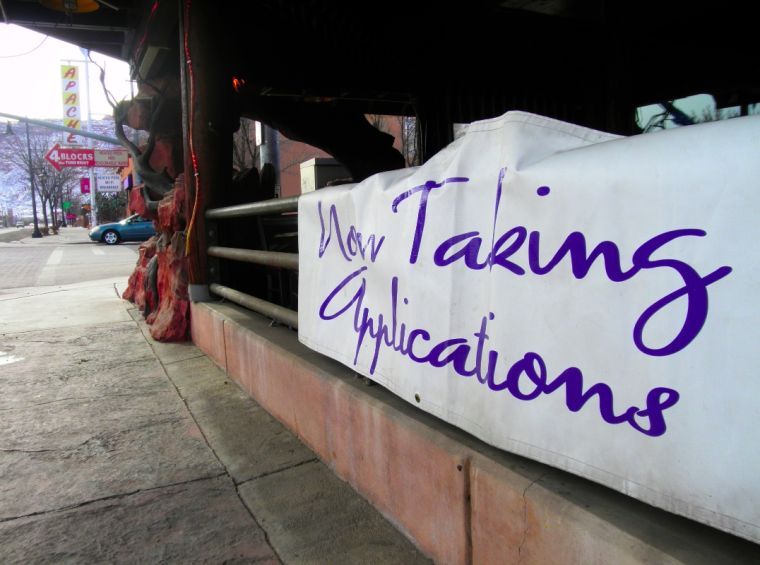Businesses are now starting to gear-up for the coming season.
Signs around town announce that businesses have begun accepting applications for the coming tourist season. Utah Department of Workforce Services held a job fair from 8 a.m. to noon, Wednesday at the Moab Arts and Recreation Center.
“One of the real benefits of the job fair is that it is a convenient way for employers and employees to go to one place and see the options, alternatives and other openings,” said Ken Davey, Moab’s administrative analyst and economic development specialist.
The Department of Workforce Services, which has offices on Kane Creek Blvd., is available to assist job seekers in putting together resumes. The state office posts local jobs in their office, as well as has the largest database of job openings in the state online at jobs.utah.gov.
Job seekers can register online with Workforce Services to apply for jobs, as well as have potential employers view their resumes.
“Employers can post jobs online by contacting either the local or state office,” said Kelly Thornton, workforce development specialist.
The single greatest employment challenge for both employers and prospective employees in Moab is the seasonal nature of the tourist economy.
“Seasonality is the biggest challenge in finding jobs for people,” said Teressa Lammert, the Moab branch manager for SOS Employment Group. SOS matches workers with jobs, free of charge, and provides services like drug screening and background checks for employers.
Despite the fact that the tourist season is lengthening each year, businesses still must substantially cut their hours and workers during the off-season.
Quinstar’s yearly employment swings are an emblematic example of the rest of the local industry. Though in the peak season the management firm, which runs several large hotels in Moab, including the Ramada and Best Western Greenwell, hires around 200 people, they can only keep 20-percent of their staff year-round, said Steve Wang, Quinstar’s managing director.
For restaurants the trend is even more pronounced.
“In the middle of summer we have 15 or 20 servers working full-time,” said Vanessa Scow, a manager at Zax. “In the winter we only have two servers working each night.”
Because of the massive portion of Grand County’s economy that is dependent on tourism (33.6 percent on hospitality alone, compared with 11.1 percent statewide, according to State of Utah statistics), Moab is especially vulnerable to dips in the national economy.
Following the 2008-09 recession unemployment numbers spiked to 20 percent in January of 2010 and 7.5 percent in June of the same year. Since then that number has fallen to 16.4 percent in January of last year and 6.5 percent in June.
The seasonal pendulum swing of employment in Moab, however, is not the only adverse factor local workers must contend with; the average monthly wage in Grand County, $2,340, is nearly a third less than the state average, $3,304, according to data from the Department of Workforce Services.
“There are no programs to help people that are underemployed or unemployed in Moab. The state often talks about how important the tourist industry is, but they don’t back it up as much as they could with job services,” Davey said. “Trying to raise a family here on a service salary is very difficult.”
But many businesses in town believe that it can be a challenge to find people who want to work year-round. They believe that the seasonal nature of employment is actually one of Moab’s big draws.
“It seems that there are quite a few people in the local workforce that don’t want to have work year-round,” said Patrick Neff, the VP for finance and administration at Synergy, a local supplement company.
“It would be relatively easy to work up to a year-round job, if you work on your skill set and take a long-term view,” Wang said. “But most people take a short-term outlook when they start.”
But, most seasonal businesses do seem to have a core group of staff that keeps coming back, year after year.
“We have pretty good return employment,” said Naomi Renn, the operations manager at the Gonzo Inn.
Though they have a staff of around 23 in the summer, the Gonzo Inn only expects to have to hire four to five new people this year.
Tour companies seem to operate the same way, with many of their guides coming back each year.
“We usually don’t have a huge turn-over,” said Arlo Tejada, co-owner of Sherry Griffith Expeditions. “We will probably hire less than five new guides, and Moab is such a draw that we usually get 100-plus applications for five openings.”
And it is not just the service industry that is hiring this month, UMTRA, which will resume tailings cleanup in early March, also has several openings. And it is possible that more will open up if some members of the crew that were laid off last year decide not to come back, said Lee Shenton, the liaison between the county and UMTRA.




